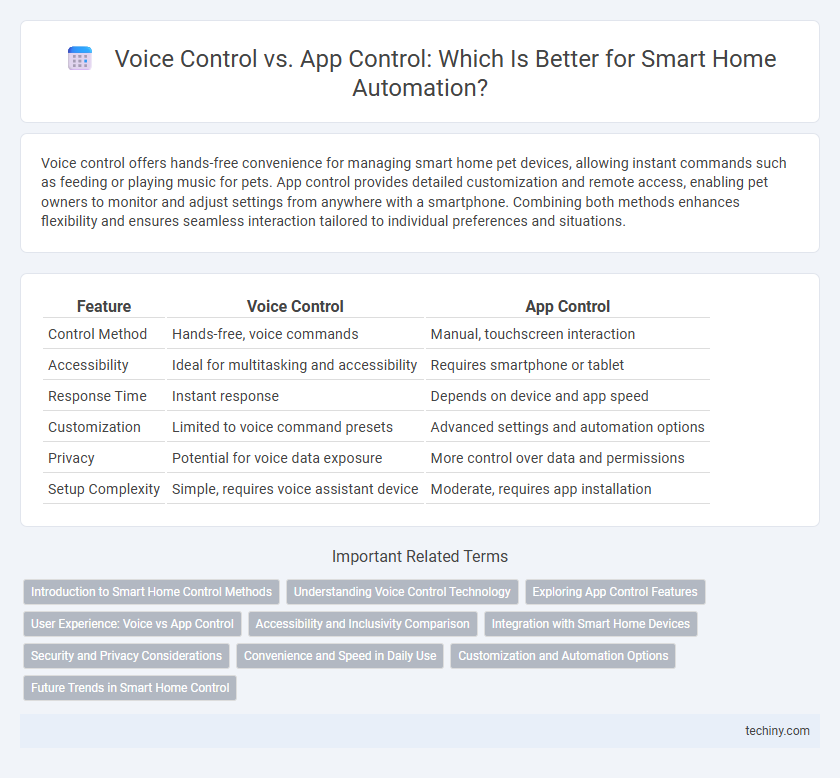Voice control offers hands-free convenience for managing smart home pet devices, allowing instant commands such as feeding or playing music for pets. App control provides detailed customization and remote access, enabling pet owners to monitor and adjust settings from anywhere with a smartphone. Combining both methods enhances flexibility and ensures seamless interaction tailored to individual preferences and situations.
Table of Comparison
| Feature | Voice Control | App Control |
|---|---|---|
| Control Method | Hands-free, voice commands | Manual, touchscreen interaction |
| Accessibility | Ideal for multitasking and accessibility | Requires smartphone or tablet |
| Response Time | Instant response | Depends on device and app speed |
| Customization | Limited to voice command presets | Advanced settings and automation options |
| Privacy | Potential for voice data exposure | More control over data and permissions |
| Setup Complexity | Simple, requires voice assistant device | Moderate, requires app installation |
Introduction to Smart Home Control Methods
Voice control offers hands-free convenience and seamless integration with AI assistants like Amazon Alexa and Google Assistant, enabling users to manage smart home devices through natural language commands. App control provides detailed customization and remote access via smartphones or tablets, allowing precise scheduling, monitoring, and device management from anywhere. Both methods enhance smart home functionality, combining ease of use with comprehensive control options.
Understanding Voice Control Technology
Voice control technology in smart homes uses natural language processing (NLP) and machine learning algorithms to interpret and execute user commands through devices like Amazon Alexa, Google Assistant, and Apple Siri. This technology enables seamless interaction by recognizing speech patterns, context, and intent, providing hands-free convenience and accessibility for controlling lighting, thermostats, security systems, and entertainment. Optimizing voice control systems involves continuous updates to speech recognition accuracy, integration with Internet of Things (IoT) devices, and enhanced semantic understanding to improve response time and user experience.
Exploring App Control Features
App control offers granular customization for smart home devices, enabling users to schedule routines, adjust settings remotely, and receive real-time status updates. Advanced features include geofencing to automate actions based on location and integration with multiple device ecosystems for seamless management. The user-friendly interfaces of smart home apps enhance convenience by consolidating control into a single platform accessible from smartphones and tablets.
User Experience: Voice vs App Control
Voice control offers hands-free convenience and faster interaction by enabling users to operate smart home devices through natural language commands, enhancing accessibility for all age groups. App control provides a visual interface with detailed settings and customization options, allowing users to monitor device status and create complex automation routines. Both methods contribute to an intuitive user experience, but voice commands excel in spontaneity while apps offer precision and comprehensive control.
Accessibility and Inclusivity Comparison
Voice control enhances smart home accessibility by enabling hands-free operation, benefiting users with mobility impairments or visual disabilities. App control offers detailed customization and remote access, but can be less intuitive for individuals with limited tech skills or dexterity challenges. Combining both methods ensures inclusivity, addressing diverse user needs and fostering a more adaptable smart home environment.
Integration with Smart Home Devices
Voice control offers seamless integration with a wide range of smart home devices, enabling intuitive, hands-free management through natural language commands. App control provides detailed customization and centralized access, supporting complex routines and multi-device coordination within a single interface. Both methods enhance smart home functionality but differ in user interaction style and integration depth.
Security and Privacy Considerations
Voice control in smart homes introduces potential vulnerabilities due to always-on microphones, increasing the risk of unauthorized eavesdropping and data breaches. App control offers stronger security measures through encrypted authentication and user-specific access controls, reducing the likelihood of external intrusions. Prioritizing multi-factor authentication and regular software updates enhances privacy protection regardless of the control method employed.
Convenience and Speed in Daily Use
Voice control offers unparalleled convenience and speed for smart home management, enabling hands-free operation and immediate response to commands. App control provides detailed customization and remote access but often requires multiple taps, making it less efficient for quick daily tasks. Combining both methods enhances user experience by balancing instant voice commands with comprehensive app-based settings.
Customization and Automation Options
Voice control offers hands-free customization by allowing users to create personalized commands and routines using natural language, enhancing convenience and real-time adaptability. App control provides deeper automation options with granular settings, scheduling capabilities, and integration with multiple smart devices for complex, scenario-based management. Combining both methods delivers a robust smart home experience, balancing immediate responsiveness with detailed configurability.
Future Trends in Smart Home Control
Voice control in smart homes is rapidly advancing with AI-driven natural language processing, enabling more intuitive and personalized interactions. App control continues to evolve through enhanced user interfaces and integration with IoT devices, supporting complex automation and remote access. Future trends point to a hybrid model combining voice and app control for seamless, context-aware management of smart home environments.
Voice Control vs App Control Infographic

 techiny.com
techiny.com